Not all gardeners who grow strawberries on their plots,can boast a consistently high yield. Often the fault is due to heavy soils, the proximity of groundwater or depletion of the fertile layer. The solution to these problems can be the use of high beds for growing strawberries.
This technology, initially tested in Holland and Germany, allows you to maximize protect plants from unfavorable external conditions and significantly increase their yield. 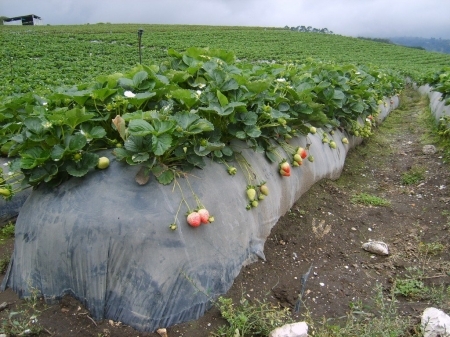
How to make high beds for strawberries
You need to plant high beds for strawberries in autumn, when harvest is harvested. Each season a new one is formed - of such a size that all plant residues from the garden are contained in it.
- A strip of any length and a width of 1.8 m, stretched from the north to the south, is selected for such a bed. In this case, the length of the selected area should exceed the length of the bed. This is necessary in order to further increase it in size.
- It should be remembered that the bed must be in a sunny place.
- The top layer of the earth is removed from the entire area of the future bed. The width of the primary embankment should be 60 cm.
- Coarse organic materials are laid in the center. Suitable branches, remains of wood, stalks of corn, flowers or sunflower. The layer is well watered.
- Over the coarse remnants a layer of 15 cm is laid juicy garden waste: the tops of root crops, whips of cucumbers, zucchini and pumpkin, stems of physalis. It should be noted that only healthy plants can be used to form the bed. Affected leaves and stems should be burned. If there are a lot of residues, then they should be interchanged with straw, so that they do not form a dense, stuck together mass. If, on the contrary, they are not enough, you can put stalks of coriander or dill between them.
- On top of the organic material, the turf removed from the bed of the bed is filled. Then the resulting layer is again watered.
- The next layer is well tamped, and then the fallen leaves are poured. Ideally, its thickness should also be at least 15 cm. But if it turns out thinner, it's okay.
- Foliage is covered with a layer of overgrown manure or one-year compost of the same thickness.
- The last layer is a ripe compost mixed with garden soil.
- As a result, the total height of the embankment should be 40-45 cm.
The bed is ready. With the onset of spring, it will be possible to plant the first plants on it.
Manufacturing of a container-bed
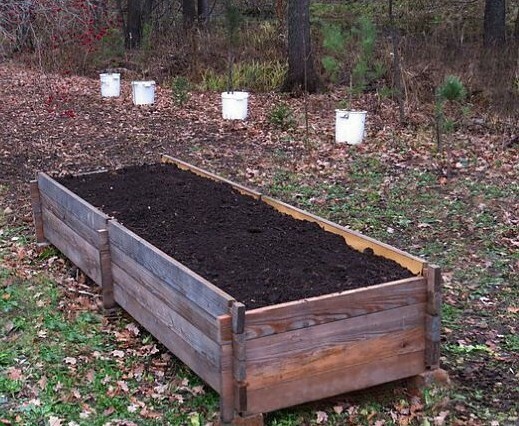 High beds with fixed sides - containers are suitable for growing strawberries. Their width is usually from 60 cm to 1 m, so that the bushes of berries are convenient to process. The length depends on the area of the site and the desire of the gardener. The height of the sides varies from 30 to 80 cm. It is quite possible to construct a bed-container for growing strawberries by oneself.
High beds with fixed sides - containers are suitable for growing strawberries. Their width is usually from 60 cm to 1 m, so that the bushes of berries are convenient to process. The length depends on the area of the site and the desire of the gardener. The height of the sides varies from 30 to 80 cm. It is quite possible to construct a bed-container for growing strawberries by oneself.
- Align the area on which the container is to be installed. Prepare the material for the walls of the future bed. Usually they are made of boards or logs, but brick and stones are also suitable. Iron or slate is better not to use, because they are too hot on sunny days, and in the shade you can not put strawberries.
- Lay out the walls of the container. They should be strong and stable, so the bottom of the material is worth digging into the ground, and the top - to be fastened together. First, they will less heat in the sun. Secondly, the smell of paint discourages pests. And, finally, the painted box looks more aesthetically pleasing.Boards and logs are knocked down by nails, and stones and bricks are combined with a mortar. The walls of the structure should be covered with paint for facades or whitewashing.
- The bottom of the container is not made so that excess moisture does not stagnate in it.
- From the finished box, the soil is removed, and then the container is filled in layers:
- The cardboard is laid on the bottom. It will protect the soil from weeds and pests.
- An uneven layer of sand is poured from above.
- On the sand is laid not rotten coarse organic.
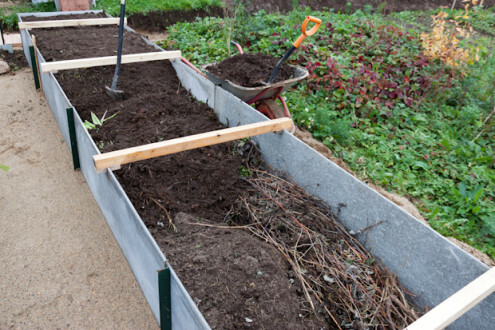
- Smaller straws are stacked over large organics: straw, grass, potato and carrot leaves, cabbage leaves, whipped zucchini and cucumber. But perennial weeds can not be used. They will sprout and spoil the filler.
- The organic layer is poured with infusion of mullein or herbs pre-crushed and fermented in a barrel for fertilizers.
- The last layer is the ground removed from the bottom of the box.
Like the high bed, the container can be used for 3-4 years. The term of its service can be extended to 6 years, but then in the last 2 years additional exhausted nutrients will have to be added to the depleted soil.
Seed beds
The box is a lower version of the container. The walls for it are made in height from 15 to 20 cm. Of course, initially the arrangement of the box will require less effort. But in the future, trouble with him will be much more. 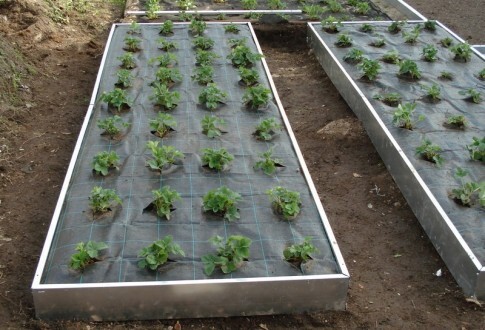
This is due to the fact that the thinner organic layer is rapidly depleted, and each year it needs to be replenished by adding fresh compost and compost to the box. In addition, the box retains moisture in a worse way, so you need to water the strawberries at least 2 times a week and update the mulching layer every time. Thus, in addition to the box, it is necessary to have a barrel with plant remains to prepare an infusion for irrigation, and a compost pile.
Planting seedlings in the soil
Planting strawberries in high beds has a number of features.
- In the early spring, before melting snow, the bed is covered with a dense film. Under it, the snow cover melts quickly, and the soil warms up well.
- In the warmed bed, azofosca or nitrophoska is scattered in the calculation of 20 g per 1 m of soil. The bed is poured very hot water and again covered with a film shelter. These works will contribute to a faster decomposition of organic matter.
- Planting seedlings of strawberries on high beds can be a few weeks earlier than in ordinary beds, because they set a high soil temperature. In case of unexpected frost, the plant can be protected with a covering material.
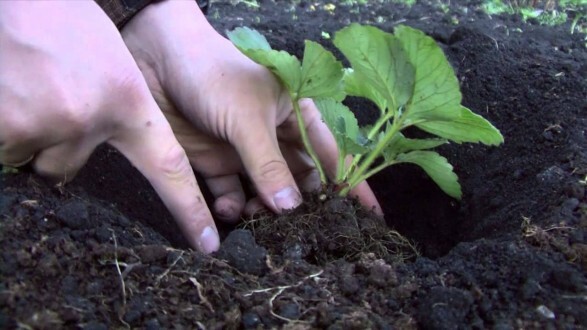
- Before planting, the garden is watered, and then dig into it 2 rows of holes, placing them in a staggered manner. The distance between the holes should be 30 cm.
- . In each well, seedlings with roots up to 5 cm long, previously disinfected in a solution of potassium permanganate or copper sulfate mixed with table salt in a ratio of 1 tsp / 3 tbsp, are placed in each well.l.for 10 liters of water.
- The roots in the hole must be in an upright position, and the central kidney should be free from the ground.
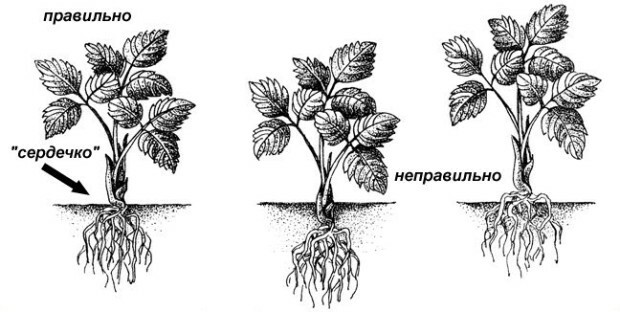
- Wells are filled with soil, and the ground around them is pressed with palms. After that, strawberries should be poured, and the ground over the entire bed is covered with a layer of mulch( peat, humus, humus or dry soil).
Features of growing strawberries on a high bed
- Strawberries, growing on a high bed, do not need additional feeding. Plants have enough nutrients that are released in the process of decomposition of organic waste.
- During the growing season, the berry should be watered abundantly. If the moisture is not enough, then the strawberry will bring a poor harvest.
- Direct sunlight should not fall on the soil under the bushes, so it must be permanently covered with a layer of mulch.
- High strawberry beds require regular weeding. It is impossible to let seeds fall from the weeds and clog up the humus. In addition, weeds take away from the bushes nutrients and water.
- To completely get rid of weeds, strawberry beds made by own hands can be covered with a black film or agrotex. To do this, holes are cut in the canvas for the bush. The rest of the space is completely closed.
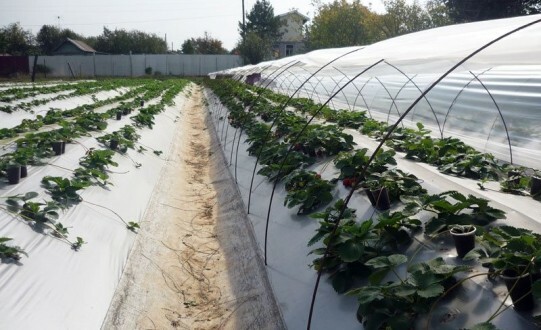
- High bed will keep its properties for 3-4 years. This is quite enough for strawberries, since a maximum of 4 years, the berry should be updated. When the old bushes are completely removed, the humus from the old bed is used to improve the quality of the soil on the new mound. In addition, it is suitable as a mulch.
As you can see, the use of a high bed for growing strawberries is unquestionable. If you initially make the effort and make small financial investments, you can get a rich harvest of your favorite berries.
Cultivation of strawberries on high beds - video of
Video:
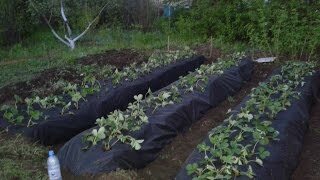 13:44
13:44 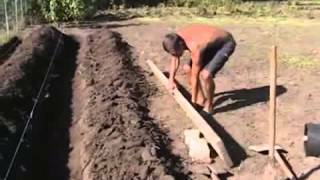 10:04
10:04  2:17
2:17 